
The bass guitar, electric bass or simply bass is the lowest-pitched member of the guitar family. It is a plucked string instrument similar in appearance and construction to an electric or acoustic guitar, but with a longer neck and scale length, and typically four to six strings or courses. Since the mid-1950s, the bass guitar has largely come to replace the double bass in popular music due to its lighter weight, the use of frets and, most importantly, its design for electric amplification.

The Gibson ES-335 is a semi-hollow body semi-acoustic guitar introduced by the Gibson Guitar Corporation as part of its ES series in 1958. It features a solid maple wood block running through the center of its body with upper bouts that are hollow and two violin-style f-holes cut into the top over the hollow chambers. Since its release, Gibson has released numerous variations of and other models based on the design of the ES-335.
The Fender Jaguar is an electric guitar by Fender Musical Instruments characterized by an offset-waist body, a relatively unusual switching system with two separate circuits for lead and rhythm, and a short-scale 24" neck. Owing some roots to the Jazzmaster, it was introduced in 1962 as Fender's feature-laden top-of-the-line model, designed to lure players from Gibson. During its initial 13-year production run, the Jaguar did not sell as well as the less expensive Stratocaster and Telecaster, and achieved its most noticeable popularity in the surf music scene. After the Jaguar was taken out of production in 1975, vintage Jaguars became popular first with American punk rock players, and then more so during the alternative rock, shoegazing and indie rock movements of the 1980s and 1990s. Fender began making a version in Japan in the mid-1980s, and then introduced a USA-made reissue in 1999. Since then, Fender has made a variety of Jaguars in America, Mexico, Indonesia and China under both the Fender and Squier labels. Original vintage Jaguars sell for many times their original price.
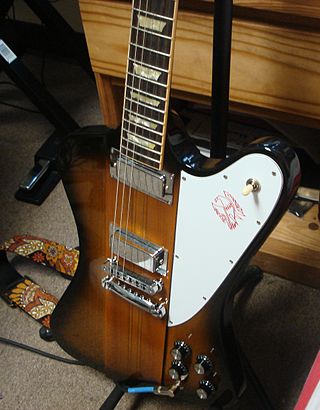
The Gibson Firebird is a solid-body electric guitar manufactured by Gibson beginning in 1963.
The Gibson EB-3 is an electric bass guitar model produced by the Gibson Guitar Corporation.
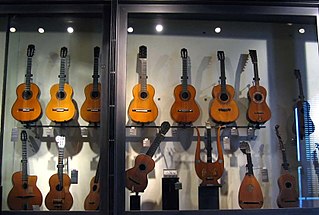
The following outline is provided as an overview of and topical guide to guitars:
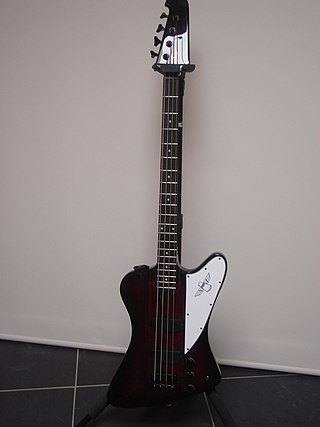
The Gibson Thunderbird is an electric bass guitar made by Gibson and Epiphone.

The Gibson ES-135 is a semi-hollow body electric guitar made by the Gibson Guitar Corporation. Originally introduced in 1956, it was discontinued in 1958. Some guitars were stamped with and marketed as an ES-130. The original run amounted to 556 instruments produced. The model, with some modifications, was reintroduced in 1991 and remained in production until 2004.
The Fender Telecaster Bass is an electric bass introduced in 1968 by Fender Musical Instruments Corporation. With few physical changes through the 1970s, it was discontinued in 1979 and reissued in 2007 by Fender's subsidiary Squier as the Squier Vintage Modified Precision Bass TB, which was discontinued in 2014.
The Gibson Les Paul bass is a bass guitar first manufactured by Gibson in 1969, just after the relaunch of the Les Paul guitar in 1968.

Kalamazoo is the name for two different lines of instruments produced by Gibson. In both cases Kalamazoo was a budget brand. The first consisted of such instruments as archtop, flat top and lap steel guitars, banjos, and mandolins made between 1933 and 1942, and the second, from 1965 to 1970, had solid-body electric and bass guitars.

The Rickenbacker 360/12 is the Rickenbacker company's 12-string variant of their 360 electric guitar model. Mainly known for producing "jangly" sounds, it was among the first electric 12-string guitars. The 360/12 was given worldwide attention when George Harrison used it on many Beatles recordings, introducing the distinctive new sound of this guitar on "I Call Your Name", which the band recorded in March 1964. In the late 1960s, the company made alternative models such as the Rickenbacker 370/12, which became the favored instrument of Roger McGuinn of the Byrds.
The Gibson ES series of semi-acoustic guitars are manufactured by the Gibson Guitar Corporation.
The Epiphone Sheraton is a thinline semi-hollow body electric guitar. Though the Sheraton and all its variations were introduced under the ownership of the Gibson Guitar Corporation, Epiphone is the exclusive manufacturer.

Duesenberg is a brand for electric string instruments founded in 1986 and located in Hannover, Germany. The headquarter is in Hannover, Germany, they are known for using a Plek machine for the levelling of frets and setup. Duesenberg has uploaded a factory production video of how their guitars are made, revealing that most of the production of the guitars is done in Croatia, while the final setup and assembly is done in Germany.

The Gibson ES-333 is a semi hollow body electric guitar made by Gibson Guitar Corporation.
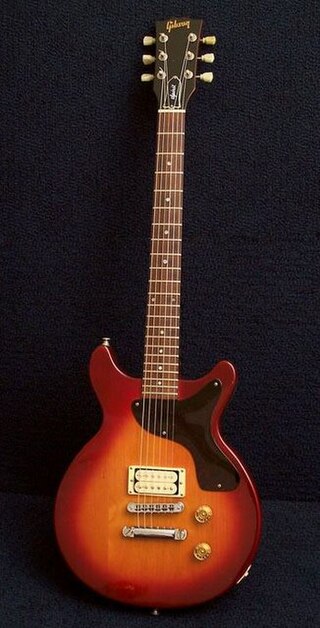
The Gibson Spirit was a guitar model sold under Gibson and Epiphone USA nameplates in the 1980s. This article does not refer to the made-in-China Spirit guitar sold under the Gibson Baldwin Music Education nameplate.
Jens Ritter Instruments is a manufacturer of high-end electric string instruments. It was founded by Jens Ritter in the mid-1990s and was known as Ritter Bass Guitars until 2010 when Jens expanded his line to include guitars. Jens produces 50 to 60 handmade instruments each year in his shop located in the small wine town of Deidesheim,Germany.
The Fender Telecaster, colloquially known as the Tele, is an electric guitar produced by Fender. Together with its sister model the Esquire, it was the world's first mass-produced, commercially successful solid-body electric guitar. Its simple yet effective design and revolutionary sound broke ground and set trends in electric guitar manufacturing and popular music.
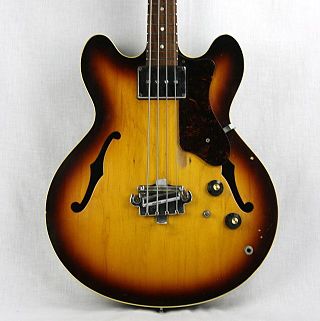
The Epiphone Rivoli was a semi-hollowbody electric bass guitar designed by Gibson and built by Epiphone in Kalamazoo, Michigan from 1959 until 1970. From 1993 until 1999, the model was reissued as a part of the Korean-Japanese Epiphone line.












